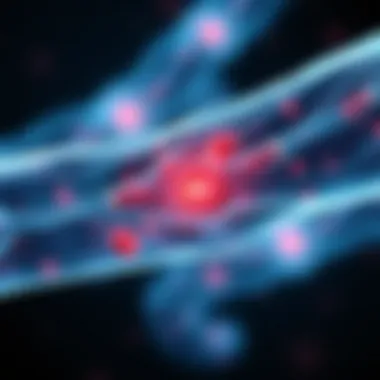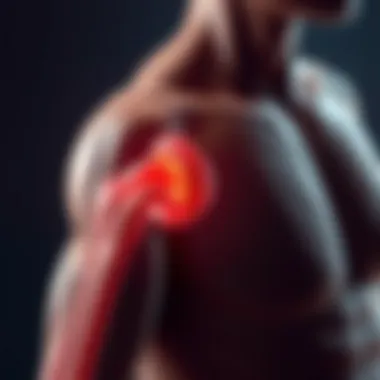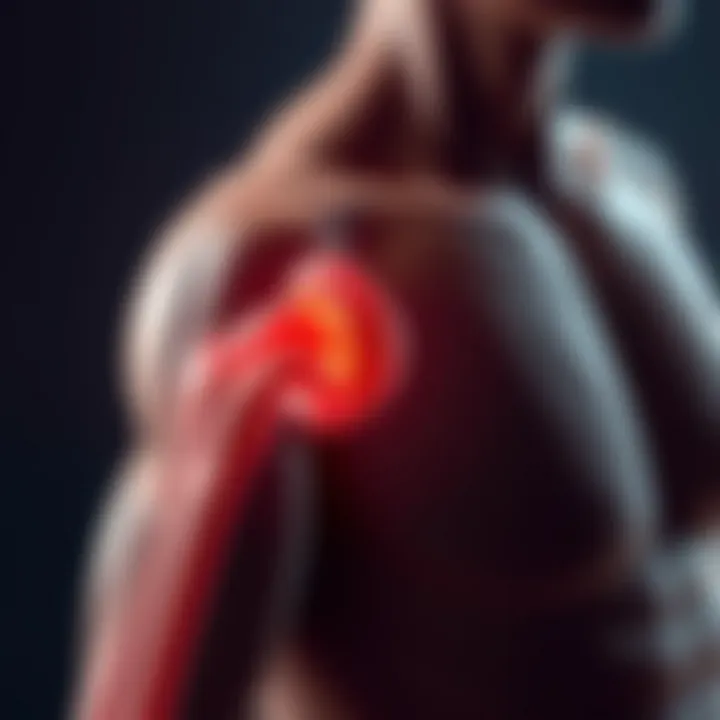The Impact of Rheumatoid Arthritis on Muscle Health


Intro
Rheumatoid arthritis is often thought of as a joint disease, a source of pain and stiffness that brings daily life to a grinding halt for many individuals. However, its impact does not end at the joints. As it unfolds, this autoimmune condition can have far-reaching effects on muscular health that are not immediately apparent yet critically important for those living with it.
Understanding the interplay between rheumatoid arthritis and muscle function is vital. Muscles are the powerhouse of movement, supporting everyday tasks from walking to lifting. When rheumatoid arthritis influences muscular health, the consequences can ripple through one’s entire lifestyle. The nuances of these relationships are what this article aims to explore, shining a light on how rheumatoid arthritis can compromise muscle integrity, leading to various physiological changes.
By delving into these connections, healthcare professionals can implement more effective rehabilitative strategies, allowing individuals to manage their symptoms better. In this narrative, we will unfold various mechanisms that define this complex relationship, followed by an overview of therapeutic approaches that aim to enhance muscular resilience in the face of this challenging condition.
As we proceed, we shall dive into the research that underscores these connections, dissecting findings and comparing methodologies employed across various studies to paint a comprehensive picture of the landscape surrounding rheumatoid arthritis and muscular health.
Overview of Rheumatoid Arthritis
Rheumatoid arthritis (RA) is more than just a common name tossed around in waiting rooms; it's a complex and challenging disorder that impacts many aspects of health. To grasp the full scope of RA, particularly its implications on muscular health, one must understand foundational elements about the disease. This section serves as a crucial platform that dives headfirst into the essentials of rheumatoid arthritis, emphasizing the importance of awareness and education for patients, healthcare providers, and caregivers alike.
Effects of RA do not merely stop at joint degradation; they ripple out into the surrounding musculoskeletal network. Understanding what RA is, its demographics, and the underlying biology contributes significantly to comprehending how it influences muscle. Without this foundational knowledge, both patients and practitioners could find themselves navigating these turbulent waters without a compass.
Definition and General Characteristics
Rheumatoid arthritis is an autoimmune disorder where the immune system, typically a guardian of our body, mistakenly attacks the synovium—the lining of the joints. When this occurs, inflammation shines a spotlight on affected joints, leading to pain, swelling, and eventually erosion of cartilage and bone. Characteristics of RA often include symmetrical joint involvement, morning stiffness lasting for more than an hour, and potential systemic symptoms such as fatigue and fever. Those experiencing RA may characterize their journey as navigating a rollercoaster of flare-ups and remissions, making understanding the disease's nuances vital.
Epidemiology and Demographics
Prevalence Rates
Rheumatoid arthritis has a notable presence across various cultures and geographies; its prevalence rates can shed light on the magnitude of the condition. Current estimates suggest that about 0.5% to 1% of the global population suffers from RA, though this figure may vary based on factors like geographic location and methodology of study. The implications of knowing prevalence rates highlight the necessity for early diagnosis and intervention, both keys to managing this intricate disease effectively. Moreover, recognizing these figures can shape public health discussions, leading to enhanced support and resources for affected individuals.
Age and Gender Factors
Age and gender also come into play when discussing rheumatoid arthritis. Statistically, women are significantly more likely to develop RA than men, with ratios suggesting that for every man diagnosed, approximately two to three women are affected. The incidence of RA typically peaks between the ages of 30 and 60, which indicates that younger adults face a unique set of challenges during this period of their lives. This gender disparity not only informs research directions but also signifies the need for targeted awareness campaigns tailored to varied demographic segments.
Pathophysiology of Rheumatoid Arthritis
Immune System Involvement
Delving deeper into the mechanics of rheumatoid arthritis, one cannot overlook the role of the immune system. The disorder arises from a complex interplay of genetic predisposition and environmental triggers, prompting an immune response that's more destructive than protective. The presence of certain antibodies, such as rheumatoid factor and anti-citrullinated protein antibodies, can further complicate the clinical picture, making early detection critical for management. Failing to appreciate these intricacies may lead to an incomplete understanding of how RA affects both joints and muscles.
Inflammatory Processes
The inflammatory processes underpinning RA are pivotal, catalyzing muscle degradation and weakness alongside joint deterioration. Proinflammatory cytokines, such as tumor necrosis factor-alpha and interleukin-1, perpetuate a cycle of inflammation, leading to increased muscle catabolism. Over time, chronic inflammation can result in muscle atrophy and reduced physical function—complications that are often overlooked in everyday clinical settings. Recognizing these inflammatory pathways is essential, as they offer insights into potential therapeutic targets for improving the quality of life of those living with RA.
The understanding of rheumatoid arthritis encompasses not only its direct impacts but also the cascading effects it has on muscular health.
Muscle Anatomy and Function
Understanding muscle anatomy and function is vital in exploring how rheumatoid arthritis can affect muscular health. Muscles are not just passive structures; they play a significant role in movement, posture, and overall bodily functions. By dissecting the intricacies of muscle anatomy, we can glean insights into how rheumatoid arthritis disrupts these mechanisms and leads to complications.
Muscle anatomy can be broadly categorized into several types, each with its distinct characteristics. This foundational knowledge will prove beneficial when addressing the challenges posed by rheumatoid arthritis.
Types of Muscle Tissue
Muscle tissue can be classified into three primary types: skeletal muscle, smooth muscle, and cardiac muscle. Each type has unique structures and functions, which makes them all integral to bodily operations.
- Skeletal Muscle: This is the most abundant type, accounting for up to 40% of body weight. Skeletal muscles are voluntary and striated, meaning they can be controlled consciously and have a striped appearance under a microscope. Their primary role is to facilitate movement by acting on bones. This is particularly relevant in the context of rheumatoid arthritis, as any degradation or impairment of these muscles can significantly limit physical capabilities.
- Smooth Muscle: Found in organs and vessels, smooth muscle is involuntary and not striated. Its contractions help regulate various autonomic functions, such as digestion and blood circulation. Although not directly involved in skeletal movement, its impairment can affect the overall well-being of individuals with rheumatoid arthritis by impacting organ systems.
- Cardiac Muscle: This muscle type is unique to the heart and is responsible for the involuntary contractions that pump blood. While not typically discussed in the context of rheumatoid arthritis, the overall health of an individual’s cardiac muscle may still be influenced indirectly through systemic inflammation.
Each muscle type displays specific characteristics that underline their functional significance. For muscle health, understanding these distinctions is crucial, particularly for those suffering from rheumatoid arthritis.
Role of Muscles in Movement
Skeletal Muscles
Skeletal muscles are the primary drivers of movement in the body. When they contract, they pull on bones to create motion, which comprises all physical activities from walking to intricate hand movements. In the face of rheumatoid arthritis, the inflammation can lead to a decline in muscle performance. For instance, muscle atrophy can set in due to disuse caused by joint pain, leading to weaker muscular structures. Hence, maintaining the health of skeletal muscles is essential for preserving mobility and quality of life. One key advantage of skeletal muscles is their ability to adapt through strength training, which can counteract some effects of rheumatoid arthritis when managed properly.
Smooth and Cardiac Muscles
Smooth and cardiac muscles, while operating differently than skeletal muscles, still contribute to overall well-being. Smooth muscles assist in regulating bodily functions by ensuring that internal organ systems operate seamlessly. For instance, compromised smooth muscle function can lead to issues such as impaired digestion, adding another layer of difficulty for someone managing rheumatoid arthritis. The unique feature of cardiac muscle is its resilience; despite systemic issues prompted by rheumatoid arthritis, it’s designed for endurance. However, any strain on the cardiovascular system due to joint-related discomfort may impact overall recovery and health.
Interactions Between Muscles and Joints
Muscles and joints function in tandem, creating a balance that allows for smooth movement. The relationship between them is intricate; muscles help stabilize joints and facilitate movement, while joints provide the necessary pivot points for these actions. In individuals with rheumatoid arthritis, joint inflammation can lead to compensatory movement strategies, which place additional strain on surrounding muscle groups.
This interaction becomes crucial in understanding how rheumatoid arthritis can extend its impact beyond joints and into muscle health. As adaptations take place in response to joint dysfunction, certain muscles may become overworked while others weaken, leading to an overall decrease in muscular function and increasing further complications.
Overall, the interplay between muscle anatomy and function provides a necessary lens to examine the consequences of rheumatoid arthritis as it pertains to muscular health. A nuanced grasp of this relationship can illuminate potential pathways for rehabilitation and management, making it a fundamental aspect of this discussion.
Impact of Rheumatoid Arthritis on Muscles
Rheumatoid arthritis (RA) primarily manifests through inflammatory processes that compromise joint integrity, yet its implications for muscular health are profound. Understanding how RA affects muscles is crucial for comprehensive patient care. If the joints are weakened, the adjacent muscles start to bear the brunt, which can lead to a cascade of muscular issues. By delving into the impact on muscle integrity and performance, we can appreciate the interconnectedness of joint and muscular health.
Direct Effects on Muscle Integrity
Muscle Atrophy


Muscle atrophy, a key concern in the context of rheumatoid arthritis, is characterized by the shrinking of muscle fibers due to various factors, including inflammation and disuse. The predominant aspect of muscle atrophy in RA patients is its direct response to the joint pain, where diminished activity leads to muscle loss. This relationship underscores the importance of muscle preservation as it plays a crucial role in overall mobility and function. Understanding muscle atrophy allows healthcare professionals to tailor interventions to counteract these losses.
In particular, a unique feature of muscle atrophy is the balance it must strike between inflammation and muscle health. Targeting inflammation can indeed curtail atrophy’s progression, thereby fostering better outcomes for patients. However, addressing this challenge remains a double-edged sword, as too much focus on inflammation can overlook the benefits of maintaining some level of physical activity.
Weakness in Affected Areas
Weakness in affected areas is another significant outcome of rheumatoid arthritis that often goes unnoticed but can severely impair quality of life. The key characteristic here is muscle weakness directly correlated to the joints with the greatest inflammation. This aspect is crucial because strength loss in specific muscle groups can lead to further joint instability and a vicious cycle of deterioration. This weakness presents an opportunity for creating rehabilitative strategies that aim to bolster muscle strength around vulnerable joints.
Unique to this discussion is the factor of localization; weakness typically occurs in muscle groups adjacent to inflamed joints. Therefore, addressing weakness in these isolated areas may provide targeted relief and restoration of function. Clinicians and patients alike can leverage this knowledge to focus rehabilitation efforts where they’re needed most.
Indirect Consequences of Joint Dysfunction
Compensatory Mechanisms
Compensatory mechanisms arise in response to joint dysfunction and play a notable role in how muscles adapt or fail in the presence of rheumatoid arthritis. When primary joints experience pain or dysfunction, the body naturally seeks alternative methods to maintain movement and balance. This adaptive response can often lead to overplaying certain muscle groups while neglecting others, subsequently altering the entire musculoskeletal landscape.
One of the beneficial aspects of understanding these compensatory mechanisms is that it paints a clearer picture of how muscles are interrelated. This is not just about isolated muscle function; it’s about how these shifts result in larger changes throughout the body. However, its downside is the risk of developing overuse injuries in new areas that take on excessive load.
Altered Load Distribution
Altered load distribution is a significant topic that underscores the intricacies of muscle function in rheumatoid arthritis. When the joints are inflamed, they can’t absorb and distribute forces effectively, leading to an uneven load on surrounding muscles. The key characteristic here is adaptability; muscles may increase or decrease their engagement based on changes in joint stability.
A unique feature of this phenomenon is the way it highlights the importance of proprioception and balance in the musculoskeletal system. Understanding how the body redistributes strain can aid in developing targeted exercises that minimize harmful compensations while reinforcing proper mechanics. However, without careful management, altered load distribution can lead to increased fatigue and risk of injuries in non-inflamed areas.
Understanding the dual nature of muscle health in rheumatoid arthritis, which encompasses both direct and indirect effects, is critical for effective treatment planning.
In sum, the interplay between rheumatoid arthritis and muscle consequences presents a complex web of interactions that cannot be overlooked. Each day brings a chance for healthcare providers and patients to address these muscular effects, improving quality of life for those navigating the challenges of RA.
Symptoms Associated with Muscular Impairment
Understanding the symptoms associated with muscular impairment is crucial when considering the effects of rheumatoid arthritis on a person’s overall health. These symptoms not only highlight the struggles faced by individuals but also serve as a reminder of the intricate interplay between the disease and muscular welfare. Recognizing these signs can lead to more informed management strategies and therapeutic measures, subsequently improving the quality of life for those affected.
Pain and Discomfort
Pain is perhaps the most immediate and recognizable symptom of muscular impairment tied to rheumatoid arthritis. This discomfort can vary widely among individuals; some may experience a dull ache, while others may suffer from sharp, debilitating pain. It often feels like weights pressing on the muscles—each movement becomes a challenge in itself. Pain tends to exacerbate following periods of inactivity and may improve with gentle movement. However, it’s essential to note that this isn't always straightforward, as any physical activity can also bring forth unwanted aches.
Living with continuous pain can lead to anxiety and depression, creating a vicious cycle that affects mental health as well. Therefore, understanding the nature of this pain, its triggers, and how it relates to the muscle integrity is paramount for devising effective treatment plans.
Fatigue and Reduced Endurance
Fatigue, in the context of rheumatoid arthritis, can feel like trying to push a boulder uphill—impossible and exhausting. This symptom does not merely manifest as tiredness but can engulf individuals in a profound lack of energy that hampers daily activities. It can sneak up on a person, appearing without warning and leaving them grappling with a sense of weariness that is pervasive.
The reduction in endurance affects not only how long a person can engage in physical activities but also diminishes their motivation to participate in rehabilitative exercises. This feeling is often compounded by pain and discomfort, further dragging down one's spirit and complicating physical treatment strategies. Managing fatigue is not just about rest; it requires a holistic approach, often involving changes in diet, exercise, and mental health interventions.
Limitations in Physical Activity
The culmination of pain and fatigue leads to significant limitations in physical activity. Many individuals find that they are unable to engage in routines they once enjoyed. Simple tasks—like going for a walk, climbing stairs, or even standing for an extended period—may become daunting.
These limitations can lead to muscle atrophy as the inactivity exacerbates the condition. Not only does this create challenges in everyday life, but it can also hinder rehabilitation and recovery efforts. It's like trying to build a sandcastle while frantically pushing back the tide; just when progress is made, setbacks occur, leading to frustration and hopelessness.
Addressing these limitations involves strategic approaches that encompass not just medical intervention but also lifestyle alterations. Adopting suitable exercises, modifying daily routines, and seeking professional guidance can prove effective in creating a more manageable framework for those affected.
"Understanding the interrelation between pain, fatigue, and limitations is critical for effective management and rehabilitation strategies."
In summary, recognizing these symptoms connected to muscular impairment in rheumatoid arthritis is vital. This understanding paves the way for more tailored management and rehabilitation approaches aimed at alleviating suffering and enhancing the overall quality of life for individuals contending with this challenging condition.
Mechanisms of Muscle Degradation
The mechanisms underlying muscle degradation in individuals with rheumatoid arthritis are both complex and multifaceted. The physiological stress caused by the disease doesn’t just harm joints but reverberates throughout the muscle tissues, leading to detrimental changes in muscle function and integrity. Understanding these mechanisms is pivotal in developing effective treatment strategies to mitigate the impact on muscular health. Proper insights can help not only in the clinical management of rheumatoid arthritis but also in enhancing the overall quality of life for patients.
Inflammatory Factors Impacting Muscles
Cytokines
Cytokines are small proteins that play a vital role in cell signaling within the immune system. In the context of rheumatoid arthritis, they are not just mere spectators; they are active participants that worsen muscle degradation. Their main role is to mediate the inflammatory response and influence the behavior of immune cells. This is crucial because an excess of pro-inflammatory cytokines can exacerbate muscle catabolism, inducing fatigue and weakness.
Perhaps the most notorious cytokines involved are tumor necrosis factor-alpha (TNF-α) and interleukin-6 (IL-6). Their overproduction is linked to increased muscle wasting, making their study and potential targeting a beneficial aspect of research in this area. However, while they bring to the fore the urgency for treatment interventions, their exact implications can be double-edged. Chronic inflammation may lead to muscle damage but also is part of the body’s defense mechanism. Thus, understanding their unique features—such as having both beneficial and harmful roles—is essential for healthcare professionals, as they can inadvertently contribute to the complexity of managing arthritis.
Muscle Catabolism
Muscle catabolism refers to the breakdown of muscle proteins for energy. In rheumatoid arthritis, muscle catabolism often escalates, driven by inflammation and cytokine activity. As the body enters a state of heightened inflammatory response, it mobilizes resources, including protein from muscles. What sets muscle catabolism apart in this scenario is the swift imbalance it creates between muscle protein synthesis and breakdown, with the latter dominating.
A key characteristic of muscle catabolism is its ability to manifest even in the absence of significant physical activity. This unique feature makes it all the more alarming, as patients may not realize the extent of muscle loss until it's substantial. The disadvantage here is obvious—affected individuals often experience diminished capacity for daily activities, which can create a vicious cycle of inactivity and further muscle degradation. A proper understanding of muscle catabolism is crucial for developing solutions to counteract the adverse effects of rheumatoid arthritis on muscular health.
Role of Autoimmunity
The role of autoimmunity in muscle degradation is profound. Rheumatoid arthritis is fundamentally an autoimmune disorder. This means that the immune system erroneously targets the body's own tissues, including joint synovium and muscle fibers. The implications of this are significant, as the resulting inflammation can lead directly to muscle wear.
The act of the immune system attacking muscle tissues can directly compromise muscle function and vitality over time. Therein lies a need for interventions that address both the autoimmunity itself and the consequent muscular issues, as they are inextricably linked. Effective treatment strategies must not only aim to reduce inflammation but also protect muscle integrity.
As we dissect the intricate pathways involved in muscle degradation due to rheumatoid arthritis, it becomes increasingly clear that a comprehensive approach focusing on inflammation reduction, muscle protection, and rehabilitation is crucial. The interplay between the immune response and muscular health dictates much about the potential outcomes for individuals living with this chronic condition.
Diagnosis of Muscular Effects in Rheumatoid Arthritis


Understanding how rheumatoid arthritis impacts muscular health is essential for effective treatment and rehabilitation. It’s not as simple as looking at joint pain; it involves a multifaceted approach to diagnosis since muscle involvement can manifest in various ways. The significance of diagnosing muscular effects lies in its implications for tailored therapeutic strategies. Recognizing these effects can lead to better clinical outcomes, improve the quality of life for patients, and guide the healthcare team in developing comprehensive care plans.
Clinical Assessments
Clinical assessments play a pivotal role in evaluating muscular effects in individuals with rheumatoid arthritis. Health professionals often start with a detailed patient history that may include reports on muscle weakness, fatigue, or any signs of atrophy. Follow-up examinations commonly involve the use of physical tests to measure muscle strength and functionality in daily activities.
Here are several commonly used clinical assessments:
- Manual Muscle Testing (MMT): This assesses the strength of specific muscle groups and identifies any areas that are particularly weak due to the condition.
- Functional Tests: Such tests include sit-to-stand movements or walking assessments, which can highlight functional limitations stemming from muscle impairments.
- Range of Motion (ROM) Measurements: These ensure that joint restrictions affecting muscle function are accounted for, linking muscle assessment directly to joint affectedness.
These assessments help clinicians ascertain not only the extent of muscular impairment but also guide goal setting for rehabilitation efforts. Effective communication between healthcare providers and patients is crucial during this phase, ensuring all concerns regarding muscle health are adequately addressed.
Imaging Techniques
Imaging techniques have come a long way in enhancing our understanding of muscular integrity in the context of rheumatoid arthritis. These technologies provide visual insights that are essential for accurate diagnosis and treatment planning. Common modalities employed include:
- MRI (Magnetic Resonance Imaging): Not only does MRI provide detailed images of joint structures, but it also visualizes surrounding muscular tissues, enabling the detection of edema or inflammation that can point to muscle degradation.
- Ultrasound: This can provide real-time imaging of muscles and joints and is particularly useful for assessing blood flow and soft tissue changes, allowing for a better assessment of conditions affecting muscular integrity.
- CT Scans (Computed Tomography): While not as frequently used for muscular evaluation as MRI or ultrasound, CT can still offer valuable cross-sectional views, particularly in complex cases where bone and soft tissue interactions need assessment.
These imaging techniques supplement clinical assessments and offer a deeper understanding of how rheumatoid arthritis impacts muscle integrity over time, making it easier to tailor individualized treatment plans.
Laboratory Evaluations
Laboratory evaluations are key in diagnosing muscular effects associated with rheumatoid arthritis, providing biochemical insights that complement clinical and imaging assessments. Basic blood tests often include:
- Rheumatoid Factor (RF) and Anti-Citrullinated Peptide Antibodies (anti-CCP): These tests help confirm rheumatoid arthritis and assist in understanding the systemic inflammation that can affect muscular tissues.
- C-Reactive Protein (CRP) and Erythrocyte Sedimentation Rate (ESR): Both measures indicate the presence of inflammation in the body. Elevated levels may correlate with increased muscle pain or dysfunction.
- Creatine Kinase (CK) Levels: This is significant as CK can indicate muscle damage. Elevated levels often provide crucial information about muscle integrity and involvement in the disease process.
Incorporating laboratory evaluations not only enhances the comprehensiveness of the diagnosis but also supports ongoing monitoring of the condition, ensuring that muscular health is continuously evaluated alongside joint health. This holistic approach can significantly influence treatment pathways and patients' outcomes.
Management Strategies for Muscle Health
Managing the muscular health of individuals suffering from rheumatoid arthritis involves a multifaceted approach. The intersection of joint pain and muscle integrity necessitates the creation of tailored strategies that address both the physical and psychological aspects of the disease. Strengthening muscles, improving flexibility, and reducing inflammation are crucial for maintaining mobility and functionality. This section delves into various methods of management, examining their distinct characteristics and significance, ultimately aiming to bolster patient outcomes.
Physical Therapy Approaches
Physical therapy stands as a cornerstone in the management of muscular health for those with rheumatoid arthritis. It aims to restore movement, enhance strength, and reduce pain through personalized exercise regimens. Rehabilitation exercises can be tailored to the individual's abilities, targeting specific muscle groups affected by the condition.
Some physical therapy methods involve:
- Manual Therapy: Hands-on techniques that mobilize joints and soft tissues prove effective in relieving stiffness.
- Therapeutic Exercises: Supervised exercises focusing on flexibility, strength, and endurance not only improve function but also foster a sense of achievement.
- Hydrotherapy: Utilizing water resistance helps lessen joint stress while allowing for greater motion, making it easier to exercise in a supportive environment.
Effective communication between therapists and patients is essential. This two-way dialogue promotes understanding and enables easier adjustments to therapy regimes as needs change over time.
Pharmaceutical Interventions
Pharmaceutical treatments play an important role in managing muscle health in rheumatoid arthritis. They can directly address symptoms and the underlying pathways contributing to muscle degradation. There are two primary categories highlighted here that are notable for consideration.
Corticosteroids
Corticosteroids are well-known for their anti-inflammatory properties. In the context of rheumatoid arthritis, they help substantially to reduce joint swelling and pain. This reduction in inflammation can lead to an improvement in muscle function as well.
A key characteristic of corticosteroids is their rapid action, often within days of administration. Many medical professionals favor them because they can significantly alter a patient’s quality of life quickly. However, the long-term use of corticosteroids may introduce several risks like muscle wasting and bone density loss.
Unique feature: Corticosteroids can be administered through various routes, including oral and injectable forms, providing flexibility in treatment strategies.
Advantages include:
- Quick relief of inflammatory symptoms
- Potentially improved range of motion
Disadvantages:
- Long-term complications if not monitored properly, including metabolic issues.
Disease-Modifying Antirheumatic Drugs
Disease-modifying antirheumatic drugs (DMARDs) hold a significant place in managing rheumatoid arthritis, particularly for their ability to alter the course of the disease. They work to slow down or halt the progression of arthritis, which in turn can prevent further muscular degeneration.
What sets DMARDs apart is their ability to modify the immune system's path that attacks the joints and tissues, potentially leading to reduced inflammation over time. Their long-term impact is indispensable for preserving muscle and joint health.
Unique feature: They take longer to see effects, but the benefits can be substantial, encouraging a more stable condition that minimizes joint damage.
Key characteristics:
- Often require monitoring for effectiveness and potential side effects.
Advantages can include:
- Long-lasting management of symptoms
- Prevention of long-term joint damage
Disadvantages:
- Side effects may necessitate dose adjustments or change of medication; their onset can be slow.


Nutritional Considerations
Nutrition plays a vital role in muscle health management for individuals with rheumatoid arthritis. A well-balanced diet rich in anti-inflammatory foods can bolster muscle integrity and overall wellness. Foods high in omega-3 fatty acids, antioxidants, and minerals are especially beneficial.
Some important dietary inclusions might be:
- Fatty Fish (like salmon and sardines) - Rich in omega-3s, they can help reduce inflammation in both joints and muscles.
- Leafy Greens (such as kale and spinach) - Packed with vitamins and minerals that play a critical role in muscle function.
- Nuts and Seeds - They provide essential fats while delivering proteins that also promote muscle repair.
Conversely, dietary elements that may exacerbate inflammation should be limited. These include excessive sugar intake and processed foods that can increase the body's inflammatory response.
Adopting a nutrient-dense diet isn’t just about avoiding certain foods; it’s about embracing holistic health practices. Each aspect can work synergistically with treatments, enhancing muscle health while managing rheumatoid arthritis optimally.
Role of Exercise in Rehabilitation
The role of exercise in rehabilitation for individuals suffering from rheumatoid arthritis is not merely ancillary but central to promoting muscle health and overall well-being. Exercise serves as a key intervention that can mitigate inflammation, promote muscle strength, and enhance functional capabilities. While the relationship between rheumatoid arthritis and muscular health is complex, incorporating regular physical activity is vital in the journey toward managing this condition effectively.
Moreover, exercise does not only aid physical health; it can bolster mental health as well. Engaging in physical activity releases endorphins, the body's natural mood lifters, helping alleviate some of the psychological burdens associated with chronic illness. This dual benefit underscores the importance of structured exercise regimens as a foundational element of rehabilitation.
Benefits of Tailored Exercise Regimens
Tailored exercise regimens, specifically designed for those with rheumatoid arthritis, can lead to a myriad of benefits. Customized programs target individual needs, focusing on enhancing strength, flexibility, and endurance. This personalization allows for adjustments based on the severity of the disease and the current physical condition of the patient.
- Improved Strength and Endurance: Regular physical activity fosters muscle growth and endurance, combating muscle atrophy often seen with rheumatoid arthritis.
- Enhanced Flexibility: Tailored regimens emphasize flexibility exercises, thereby reducing stiffness and improving range of motion.
- Pain Management: A consistent exercise routine can help in managing pain, often reducing reliance on medications that may have undesirable side effects.
- Holistic Health Improvement: Physical activity contributes to better cardiovascular health and can improve overall physical function.
Exercise is not a one-size-fits-all solution; it requires a personalized approach to ensure efficacy
Types of Recommended Exercises
Different types of exercises are appropriate and often recommended for individuals with rheumatoid arthritis. These exercises are categorized broadly but each has its unique benefits in supporting rehabilitation goals.
Strength Training
Strength training focuses on building muscle mass and improving overall muscularity. For those dealing with rheumatoid arthritis, this type of regimen helps to counteract muscle wasting that may occur due to inactivity or inflammation. The key characteristic of strength training is its low-impact nature, allowing individuals to strengthen their muscles without aggravating their joints.
One of the unique features of this form of exercise is its ability to be modified. Different weight levels and resistance bands can be used to suit every individual's capabilities. However, caution is important; overexertion can lead to further discomfort or injury, making supervised training sessions preferable in some cases.
Aerobic Activities
Aerobic activities, such as walking, swimming, or cycling, play a significant role in enhancing cardiovascular fitness, which is often compromised in individuals with rheumatoid arthritis. The key characteristic of aerobic exercises is their ability to be performed at a gentle pace, making them accessible for those with varying degrees of mobility.
The unique aspect of aerobic activities lies in their community-oriented nature; group classes can provide social support, which can boost motivation and adherence to exercise programs. However, participants should be cautious about overly strenuous routines, as they may exacerbate joint pain if not carefully monitored.
Flexibility Exercises
Flexibility exercises focus on stretching and improving the range of motion in joints. These exercises are particularly beneficial for those with rheumatoid arthritis, as they can directly reduce stiffness and enhance mobility. The key characteristic of flexibility exercises is their gentle approach, emphasizing gradual stretching rather than intense movements.
Unique features of flexibility exercises include their ability to be performed almost anywhere and the ease of incorporating them into daily routines. However, it's important to listen to one’s body during these exercises; pushing beyond comfort can lead to strains or injuries.
Potential Complications and Prognosis
Understanding the potential complications and prognosis of rheumatoid arthritis (RA) provides crucial insight into not only the long-term effects the disease can have on muscle health but also the overall quality of life for affected individuals. As RA progresses, it can lead to a series of consequences that extend beyond joint pain and swelling. These complications can affect everything from mobility to mental well-being, emphasizing the need for a comprehensive approach to management. This section delves deeper into the implications of RA on muscle health and the perspectives from various healthcare professionals working together for the best outcomes.
Long-Term Implications for Muscle Health
Rheumatoid arthritis doesn't just play a game of tag with the joints; its long-term impact on muscle health is a complex puzzle. As inflammation persists, muscles may weaken due to disuse or altered mechanics in daily activities. This can lead to:
- Atrophy of muscle fibers: The muscles surrounding inflamed joints may not be engaged as often, leading to a decrease in muscle mass.
- Increased fatigue: The metabolic demands of both inflammation and muscle degradation can leave individuals feeling extraordinarily tired, lessening their ability to engage in physical activities.
- Compensation strategies: People may unconsciously adjust their movements to avoid pain, which can place additional strain on other muscles and lead to further injuries.
The prognosis isn't uniformly bleak; some patients do manage to maintain muscle health through strategic rehabilitation and exercise plans tailored to their specific needs. However, it is important to recognize that muscle integrity is often compromised, fostering a cyclical relationship where weakness can feed into increased joint dysfunction.
"The body is a unit. If you hurt one part, it can affect the whole."
— An important reminder that interconnectedness is key in managing RA.
Multidisciplinary Care Perspectives
Tackling the challenges posed by RA requires the collaboration of diverse healthcare professionals. This multidisciplinary approach ensures a more holistic treatment strategy, focusing on immediate muscular issues as well as their broader implications. Key players include:
- Rheumatologists: Specialists who diagnose and treat RA, aiming to reduce inflammation and manage the disease.
- Physiotherapists: Experts who design individualized exercise programs to maintain and improve muscle strength while considering limitations posed by RA.
- Dietitians: Professionals who address nutritional needs which can influence inflammation and overall health, tailoring diets that support the management of symptoms.
- Psychologists or counselors: These professionals help with the mental burden that RA can impose, providing coping strategies to combat depression or anxiety associated with chronic illness.
Integrating these perspectives into a cohesive management plan allows for ongoing assessment and adjustment of strategies aimed at preserving muscle health. The success of this multifaceted approach can hinge significantly on open communication among team members, as well as with the patient.
By fostering a comprehensive view of health that extends beyond just treating inflammation, patients are more likely to see improvements in both their muscle function and overall quality of life. For those affected by rheumatoid arthritis, understanding and addressing potential complications is a vital step in reclaiming mobility and strength.
Closure
Rheumatoid arthritis is often thought of in terms of how it affects joints, with much of the focus landing on the pain and inflammation localized in those areas. However, as presented in this article, its impact stretches much further, especially when considering muscular health. The connection between rheumatoid arthritis and muscle integrity is crucial for understanding comprehensive care and management strategies.
Recap of the Interrelation Between Conditions
The relationship between rheumatoid arthritis and muscular impairment is multi-faceted. Directly, the disease leads to muscle atrophy and weakness, spilling over into general physical limitations. When joints are inflamed, compensatory mechanisms may come into play, leading to altered movement patterns. These adaptations can inadvertently cause strain on muscle groups that are trying to offset pain in the affected joints. Such repeated patterns worsen muscle health over time, creating a vicious cycle.
- Joint Inflammation: This creates stiffness, which in turn limits mobility.
- Compensatory Movement: Altered biomechanics often place undue stress on surrounding muscles.
- Muscle Atrophy: Reduced use and increased inactivity lead to further decline in muscle strength and coordination.
Recognizing these interconnected issues enables healthcare providers to create rehabilitation plans that are holistic in nature, targeting not just the joints but also the muscles that support them. As research continues to unfold, addressing this comprehensive impact has the potential to improve overall quality of life for individuals grappling with this challenging disease.
Future Directions for Research
Looking ahead, future research efforts should focus on several key areas to deepen our understanding of how rheumatoid arthritis influences muscular health.
- Mechanisms of Muscle Involvement: Studies should delve into the molecular pathways that link inflammatory markers to muscle degradation. This includes understanding the role of cytokines in muscle wasting and potential biomarkers that indicate muscle health.
- Effectiveness of Interventions: Research should explore various interventions, including exercise regimens tailored specifically for individuals with rheumatoid arthritis, to determine their effectiveness in a clinical setting. This would help solidify recommendations for physical therapy approaches.
- Longitudinal Studies: These can help track the progression of muscle health in relation to rheumatoid arthritis over time, revealing long-term implications and potentially shifting the standard of care.















